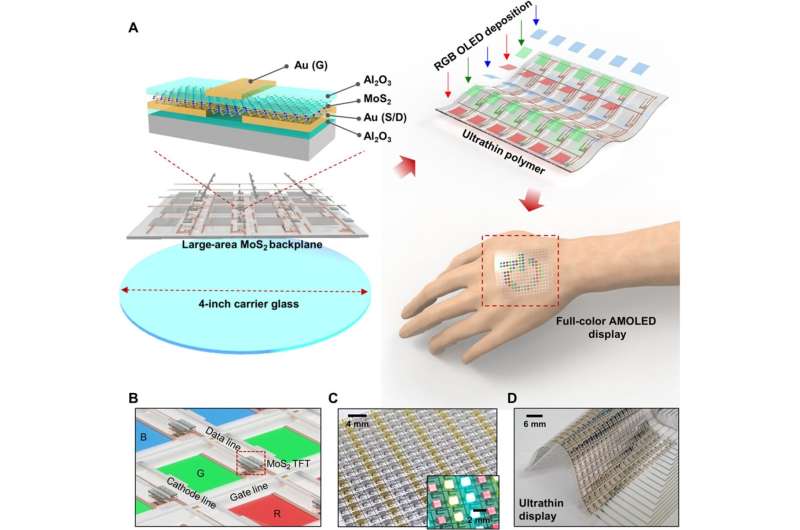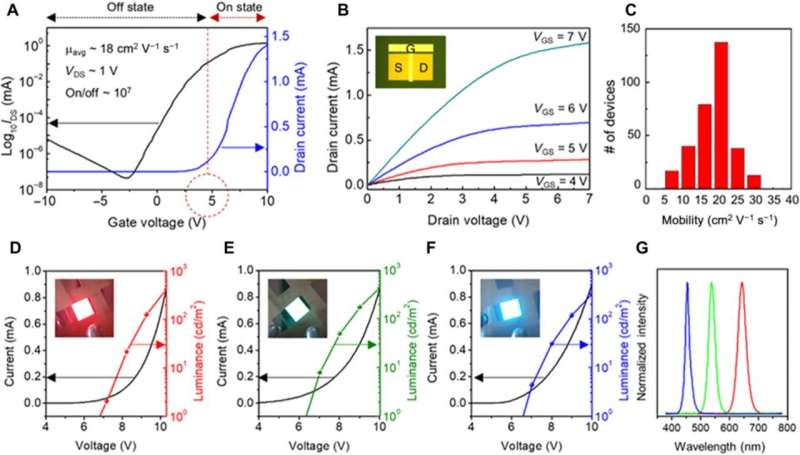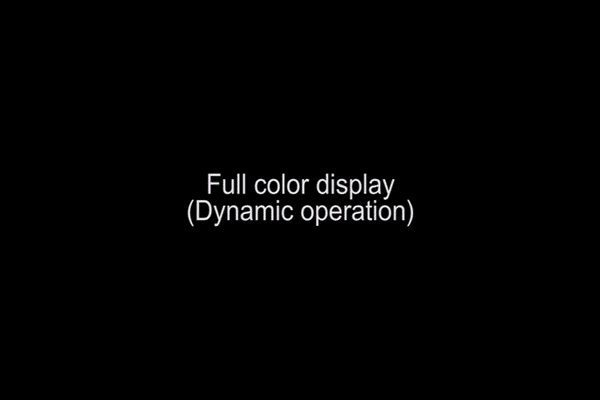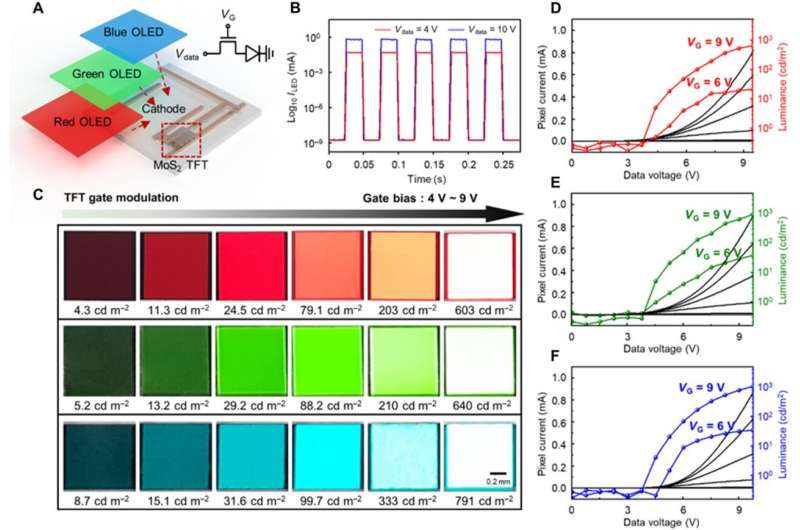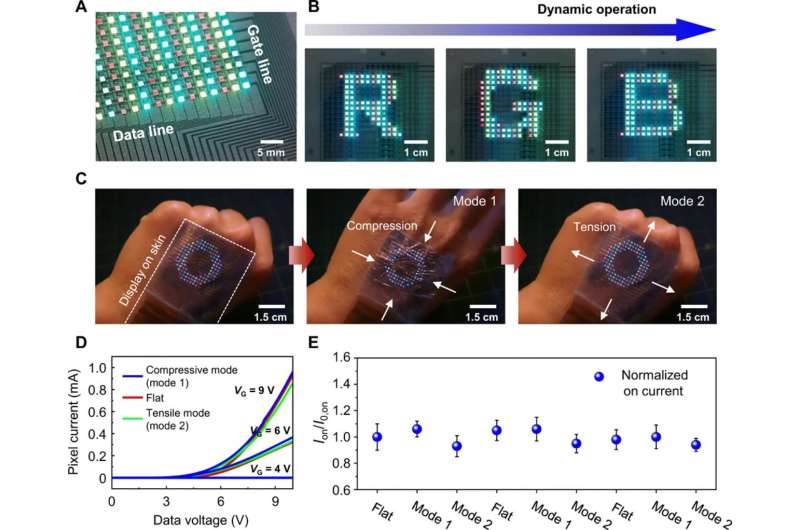The full-color AMOLED display with large-area MoS2-based backplane. (A) Schematic illustration of the high-performance MoS2-based backplane on a 4-inch carrier glass substrate, where an Al2O3 capping layer was applied for n-doping effects on the MoS2 film (top left), an active-matrix full-color display was applied to the ultrathin polymer substrate (top right), and the large-area full-color display was tested on a human hand (bottom right). (B) Scheme of the active-matrix full-color pixel array integrated with MoS2 transistors, where each pixel was connected via a gate, data, and cathode interconnector for line-addressing control. (C) Digital photograph of the active-matrix display on the 4-inch carrier glass substrate, where the inset demonstrates the full-color display when switched on. (D) Digital photograph of the large-area full-color display on the ultrathin polymer substrate, demonstrating the flexible mechanical properties due to the low bending stiffness of the ultrathin material. Photo credit: Minwoo Choi, Yonsei University. Credit: Science Advances, doi: 10.1126/sciadv.abb5898
The development of electronic applications can take on many new forms to include foldable and wearable displays to monitor human health and act as medical robots. Such devices rely on organic-light emitting diodes (OLEDs) for optimization. However, it is still challenging to develop semiconducting materials with high mechanical flexibility due to their restricted use in conventional electronic formats. In a new report on Science Advances, Minwoo Choi and a team of scientists in Electronic Engineering and Materials Science in the Republic of Korea, developed a wearable, full-colour OLED display using a two-dimensional (2-D) material-based backplane transistor. They engineered an 18-by-18 thin-film transistor array on a thin molybdenum disulfide (MoS2) film and transferred it to an aluminium oxide (Al2O3)/polyethylene terephthalate (PET) surface. Choi et al. then deposited red, green and blue OLED pixels on the device surface and observed excellent mechanical and electrical properties of the 2-D material. The surface could drive circuits to control the OLED pixels to form an ultrathin, wearable device.
Scientists and engineers must conduct extensive research in the field of wearable electronics to develop smart electronic systems focused on flexible devices and ultrathin substrates. Inherent limits of such materials have motivated the use of alternative semiconductor materials such as MoS2 for inclusion in thin-film transistors (TFTs) and logic circuits with relatively high performance. These materials are known as transition metal dichalcogenides and they provide unique electrical, optical, and mechanical properties for backplane circuitry of wearable electronics. Researchers had recently developed MoS2 transistors with sophisticated red, green and blue (RGB) colors as a fundamental and essential requirement for practical displays. In this work, Choi et al. developed a large-area MoS2 TFT array to operate 324 pixels in a 2-inch RGB OLED, in which the full-color display demonstrated an active-matrix configuration. The RGB OLEDs were made of different optoelectronic characteristics, therefore the team designed the backplane TFTs to control each color pixel. The experimental setup was promising as a wearable display and functioned steadily on human skin without adverse effects. The team used heterogenous material designs to form optoelectronics in the present work.
Device properties of the MoS2 transistor and RGB OLEDs. (A) Transfer curve of the MoS2 transistor on the 4-inch carrier glass substrate, where the average mobility of 18 cm2 V−1 s−1 was sufficient for operating the RGB OLEDs. (B) I-V characteristics of the MoS2 transistor as the gate bias was increased from +4 to 7 V, where the inset shows the MoS2 transistor. (C) Statistical analysis of the MoS2 transistor mobility across 324 samples. (D to F) I-V characteristics (left y axis) and luminance (right y axis) of the RGB OLED as a function of applied bias, where the insets visualize the emission of each OLED color. (G) EL spectra of the RGB OLED pixels. Photo credit: Sa-Rang Bae, Korea University. Credit: Science Advances, doi: 10.1126/sciadv.abb5898
Large-area active-matrix OLED (AMOLED) display
The team designed a large-area active-matrix OLED (AMOLED) display with an MoS2 backplane via a sequence of processes. They first formed a thin-film-transistor (TFT) array on a thin MoS2 film, then deposited an RGB OLED on the drain electrode of the TFTs and peeled the display from the carrier to transfer it to the human hand (the target). During the process, they synthesized a bilayer MoS2 film on a 4-inch SiO2/Si wafer via metal organic chemical vapor deposition (MOCVD). Then they coated a polyethylene terephthalate (PET) substrate with aluminium oxide using atomic layer deposition and transferred the MoS2 film from the SiO2/Si wafer to this PET substrate to produce an MoS2 transistor array with a driving backplane configuration. The resulting structure was unique and encapsulated with aluminium oxide for improved metal contacts and carrier mobility. The full-color AMOLED display uniformly controlled the RGB OLED pixels, where each pixel connected to a data and a scanning line and the entire display circuit functioned in an active-matrix design. Choi et al. controlled the pixel current based on the drain and gate signals of the transistor to change the brightness of the OLED. They could then transform the ultrathin display from the carrier glass substrate to a curved surface without device degradation.
The dynamic operation of the active-matrix display via external circuit control. Credit: Science Advances, doi: 10.1126/sciadv.abb5898
Stable display applications
The team examined the current-voltage output curves to determine the drain characteristics of the TFTs to illustrate the relationship between the drain current (IDS) and the bias voltages (VDS and VGS). The homogeneity of the MOCVD-grown MoS2 film allowed high uniformity for stable display applications. The device properties were consistent across all the samples, allowing the single pixel to operate in the full-color AMOLED, while the efficiency did not decrease. The team measured the highest luminescence at 460, 530, and 650 nm for the blue, green and red OLEDs.
At a repeated gate pulse bias of +10 volts, the OLED exhibited a rapid transition between on and off states, although the response time was limited by the measurement system, the delay time was short. Gate modulation did not occur during the off state and the pixel state remained stable, providing efficient leak-proof operation of the TFT. The pixel current also dramatically increased with increasing gate bias (VG) during the on state to reach a threshold voltage of 5 volts across the RGB OLEDs.
The properties of a single pixel integrated with the MoS2 transistor and RGB OLEDs. (A) Schematic illustration of the RGB unit pixels integrated with the MoS2 transistor in a series connection for active-matrix configuration. (B) Pixel-switching properties controlled using a gate bias of −10 and 10 V at fixed data biases of 4 V (red) and 10 V (blue). (C) Digital photograph of the luminance change in the RGB OLEDs in a gate bias range of 4 to 9 V, where the brightness of each OLED was stable and controlled by the gate signal of the MoS2 transistor. (D to F) The pixel current (left y axis) and luminance (right y axis) as a function of gate signal. Photo credit: Sa-Rang Bae, Korea University. Credit: Science Advances, doi: 10.1126/sciadv.abb5898
Proof-of-concept—wearable electronic device
The team confirmed the performance of the individual RGB pixels using the transistors and integrated an 18 x 18 array (324 pixels) to the data and gate lines of the transistor backplane circuit to form a full-color AMOLED display. They controlled each pixel via the matrix line and maintained consistent light luminescence in each individual pixel in the OLED displays. The RGB OLED pixels showed consistent and uniform brightness due to the stable control of the gate and data signals. Choi et al. drove the RGB pixel arrays sequentially via an external drive circuit configured in a commercial strip pixel structure representing the characters 'R', 'G', and 'B'.
The low stiffness of the ultrathin device prevented the deterioration of optical and electrical properties during substantial mechanical deformation reflexes—after its transfer to a human hand. Based on the current-voltage characteristics (I-V), the current level did not change during skin shrinkage or skin stretching exercises and the on-state also did not fluctuate during active-matrix display operation. While the device stability is still in development, the team aim to conduct further engineering to improve the MoS2 film for practical applications as a wearable, full-color AMOLED display.
Wearable full-color AMOLED display based on MoS2 backplane circuitry. Digital photographs of the full-color active-matrix display during (A) the “all on” state; (B) the dynamic operation of the active-matrix display, where gate and data signals were individually controlled using the external circuit; and (C) the application of the ultrathin display on a human hand, where the display was deformed by two mechanical modes based on hand motion, namely, compressive mode (center) and tensile mode (right). (D) Plots of the unit pixel current as a function of data voltage at VG values of 4 V (off state), 6 V, and 9 V in the compressive (blue), flat (red), and tensile (green) mode. At every applied gate bias (VG), negligible change in pixel current is observed under various modes of deformation, which enables stable operation of AMOLED on human hand. (E) Normalized on-state current variation of the ultrathin display on human hand during mechanical deformation. Photo credit: Minwoo Choi, Yonsei University. Credit: Science Advances, doi: 10.1126/sciadv.abb5898
In this way, Minwoo Choi and colleagues developed a thin (2-inch), wearable and full-color AMOLED display with 18 x 18 arrays using MoS2-based backplane TFTs. They built the transistor array directly on a bilayer MoS2 film grown using MOCVD and observed a high carrier mobility and on/off ratio. The team controlled the light emission of the RGB OLED pixels by applying a gate-voltage between 4 and 9 volts. They used an ultrathin plastic substrate (PET) combined with 2-D semiconducting materials to directly fabricate OLEDs for excellent electrical, optical, and mechanical performance. This experimental system can be improved for integration in wearable and electronic devices beyond the existing conventional and rigid organic materials.
More information: Minwoo Choi et al. Full-color active-matrix organic light-emitting diode display on human skin based on a large-area MoS2 backplane, Science Advances (2020). DOI: 10.1126/sciadv.abb5898
Tsuyoshi Sekitani et al. Stretchable active-matrix organic light-emitting diode display using printable elastic conductors, Nature Materials (2009). DOI: 10.1038/nmat2459
Kibum Kang et al. High-mobility three-atom-thick semiconducting films with wafer-scale homogeneity, Nature (2015). DOI: 10.1038/nature14417
Journal information: Science Advances , Nature Materials , Nature
© 2020 Science X Network
